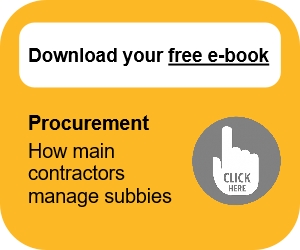Supplier selection
Contents |
[edit] Introduction
In the construction industry, ‘supplier’ is a very general term which refers to organisations contracted as part of the delivery of a built asset.
Critical steps in the supplier evaluation and selection process are:
- Recognising the need for a supplier.
- Determining the criteria for supplier selection.
- Identifying potential suppliers.
- Shortlisting suppliers.
- Evaluating and selecting the supplier.
- Contracting the selected supplier.
[edit] The need for a supplier
Suppliers might be need for a wide range of purposes, including:
- Consultancy services such as design and project management.
- Enabling and demolition works.
- The main construction contract works.
- Specialist sub-contract works.
- The supply of plant.
- The supply of products and materials.
- Maintenance and operation services.
Potential suppliers might be identified by research, advertising, recommendation, open competition (with or without design), selective competition (with or without design), or through an existing relationship such as a framework agreement.
[edit] Selection criteria
Some of the most common criteria that are used to select suppliers are set out below:
- Process and design capabilities: The supplier should have relevant previous experience, and should have the capability to supply as required.
- Quality: The product/service should be of a sufficient quality or meet the required specification.
- Cost: Total supplier costs should be assessed, including the product/service cost, ordering cost, logistics costs, lifecycle costs, delivery charges, and so on.
- Service: The ability of the supplier to provide an appropriate level of service, such as technical support post-purchase. What value added does the supplier offer?
- Capacity: The ability of the supplier to meet the requirements in accordance with the required delivery schedule.
- Location: The geographical location of a supplier may affect the delivery lead-time, transport and logistics costs, availability of support and so on.
- Management capability: The supplier’s track record on continuous improvement of their processes and standards, and their ability to maintain good relationships with their clients.
- Financial stability: Will they continue to be a reliable source of supply or are a risk to the project?
- Ordering system: The robustness and sophistication of the ordering system can impact on supply chain performance, and should be as easy and efficient as possible, with short delivery lead times.
- Compliance: Whether the supplier is fully compliant with environmental regulations, health and safety requirements, quality assurance standards and so on.
- Longer-term relationship: Whether they have the potential of being a long-term partner, with a willingness to share technologies and information in a mutually beneficial manner.
- Innovation: Is the supplier able to offer innovative products or services that would bring added value to the project?
- Proposed methodology: This might include mobilisation plans, design proposals, and non-compliant proposals if these have been allowed.
See also: Tender evaluation
[edit] Selection methods
Some of the methods that can be used as a means of determining how a supplier fits the criteria listed above include the following:
- Pre qualification questionnaire.
- Obtaining financial information, such as a publically-available report.
- Providing specifications and requesting a formal quote from the supplier.
- Pre-tender and mid tender interviews.
- Arranging a meeting or visit to the supplier.
- On-site assessment.
- Request for certificates to confirm capability.
- Feedback from other clients.
- Assessing industry databases or reviews.
- Evaluation of samples.
For more information see: Tender process and tender evaluation.
[edit] Related articles on Designing Buildings Wiki
Featured articles and news
Amendment to the GB Energy Bill welcomed by ECA
Move prevents nationally-owned energy company from investing in solar panels produced by modern slavery.
Gregor Harvie argues that AI is state-sanctioned theft of IP.
Heat pumps, vehicle chargers and heating appliances must be sold with smart functionality.
Experimental AI housing target help for councils
Experimental AI could help councils meet housing targets by digitising records.
New-style degrees set for reformed ARB accreditation
Following the ARB Tomorrow's Architects competency outcomes for Architects.
BSRIA Occupant Wellbeing survey BOW
Occupant satisfaction and wellbeing tool inc. physical environment, indoor facilities, functionality and accessibility.
Preserving, waterproofing and decorating buildings.
Many resources for visitors aswell as new features for members.
Using technology to empower communities
The Community data platform; capturing the DNA of a place and fostering participation, for better design.
Heat pump and wind turbine sound calculations for PDRs
MCS publish updated sound calculation standards for permitted development installations.
Homes England creates largest housing-led site in the North
Successful, 34 hectare land acquisition with the residential allocation now completed.
Scottish apprenticeship training proposals
General support although better accountability and transparency is sought.
The history of building regulations
A story of belated action in response to crisis.
Moisture, fire safety and emerging trends in living walls
How wet is your wall?
Current policy explained and newly published consultation by the UK and Welsh Governments.
British architecture 1919–39. Book review.
Conservation of listed prefabs in Moseley.
Energy industry calls for urgent reform.

























